Rotational rate decreased when the legs deployed (see my earlier comment), but the angular momentum is still almost identical. That is the energy that needs dissipating. A little drag plus greater authority of the CG thrusters over the gridfins (getting less effective) got them there in the end. That's what I think. The CG thrusters should have the same moment available as long as they are fed with the same gas pressure, regardless of altitude, to a first-order approximation. Less mass due to fuel use during the landing burn probably factors into the equation somewhat also.
You are using an out of date browser. It may not display this or other websites correctly.
You should upgrade or use an alternative browser.
You should upgrade or use an alternative browser.
SpaceX Falcon 9 historic landing thread (1st landing attempt & most recent missions)
- Thread starter georgegassaway
- Start date

Help Support The Rocketry Forum:
This site may earn a commission from merchant affiliate
links, including eBay, Amazon, and others.
Gas powered RCS thrusters have a lower ISP (efficiency) and thrust at sea level due to the gravitational force and the properties behind the thruster system. I agree with you that the reduced weight greatly helped and the video makes it evident that the landing gear had a substantial impact on the rotation. My guess is that the lowered velocity, decently efficient RCS thrusters, higher moment of inertia and more drag are what slowed the roll down and stabilized the booster for landing.Rotational rate decreased when the legs deployed (see my earlier comment), but the angular momentum is still almost identical. That is the energy that needs dissipating. A little drag plus greater authority of the CG thrusters over the gridfins (getting less effective) got them there in the end. That's what I think. The CG thrusters should have the same moment available as long as they are fed with the same gas pressure, regardless of altitude, to a first-order approximation. Less mass due to fuel use during the landing burn probably factors into the equation somewhat also.
Also, as it approached landing, the amount of fuel remaining approached zero and thus lowered the mass of the booster making it easier to slow the spin.
I said that earlier tooAlso, as it approached landing, the amount of fuel remaining approached zero and thus lowered the mass of the booster making it easier to slow the spin.
It will be a little dependent on how much swirl was induced in the fuel during spin, and how much internal anti-slosh baffling there is in the tank to couple the fuel rotation to the tank structure. There is likely a time delay in both directions to some extent to this effect.Less mass due to fuel use during the landing burn probably factors into the equation somewhat also.
- Joined
- Jan 17, 2009
- Messages
- 5,204
- Reaction score
- 1,547
Article on recovery efforts on the Falcon booster:
https://www.americaspace.com/2018/1...-floating-falcon-9-rocket-off-cape-canaveral/
some photos:
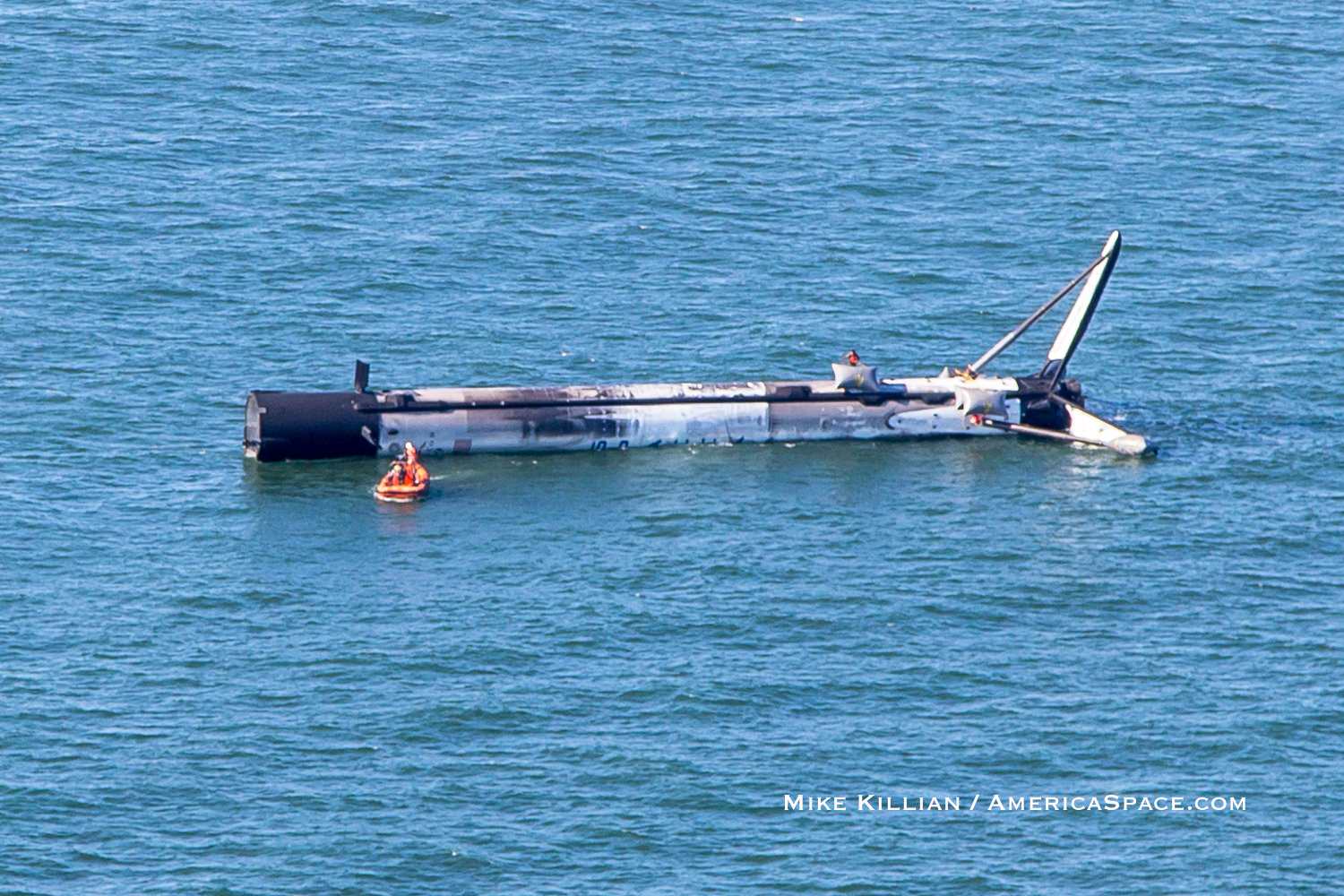
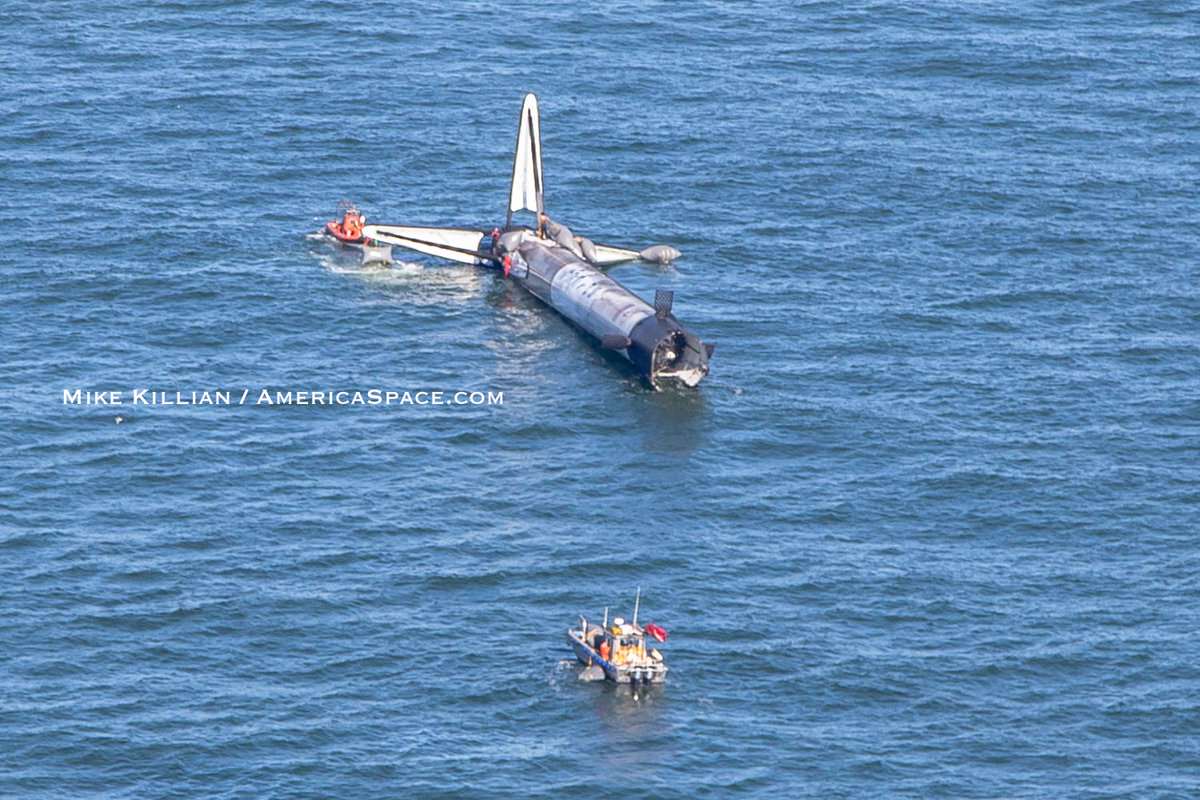
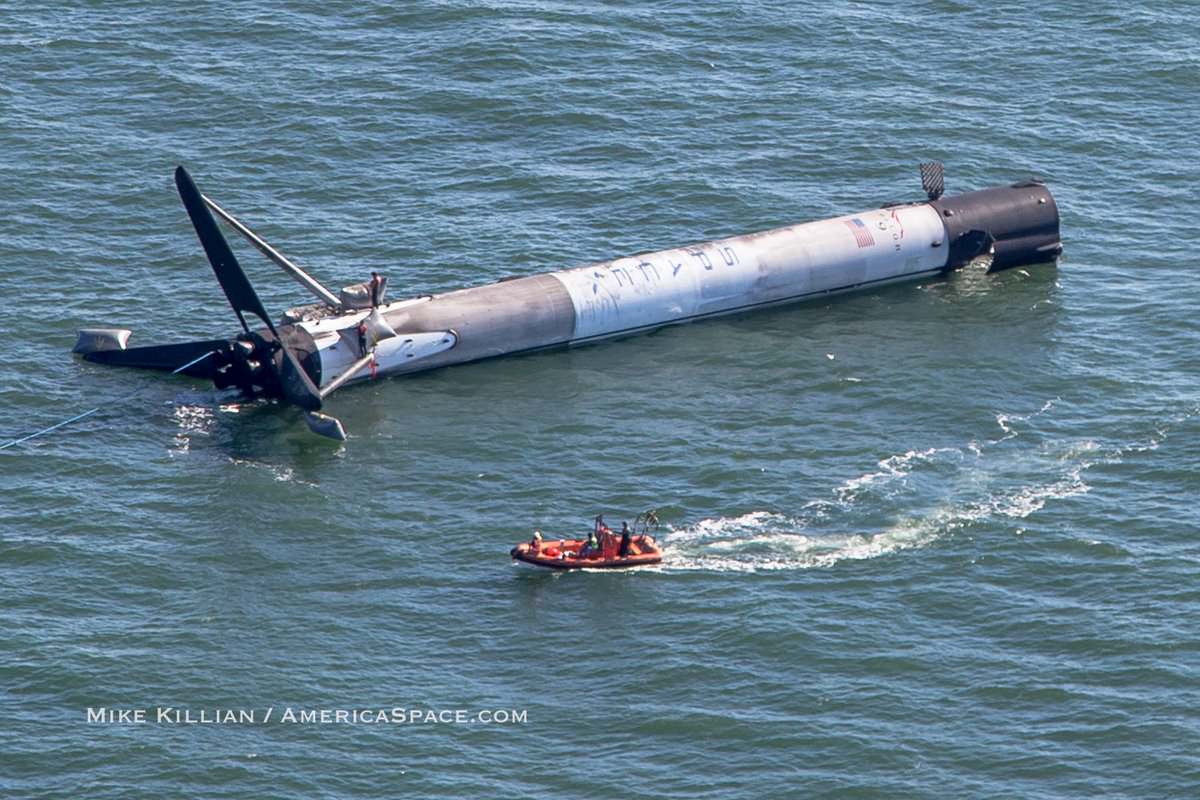
Musk claimed yesterday that SpaceX would launch this rocket again, for SpaceX payloads. I'll believe that when I see it, but don't really expect to see it. At the least it's going to need a new interstage (black area at top, a carbon-fiber structure). Interstage is badly broken along one side, probably from when it fell over and hit the water.
Enlargement from above photo:
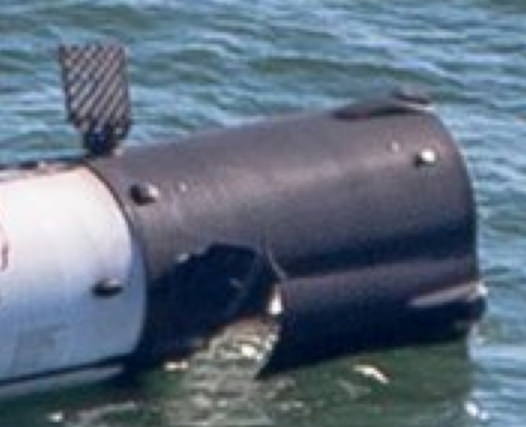
One of the legs was recovered by one of the support ships, no info on whether it broke off, or if it was purposely removed by divers today to reduce the draft so it can be towed into Port Canaveral. In the photos, you can see air bags attached to two of the legs, to help keep it from rolling over due to the mass of the leg up in the air while there's no leg to counterbalance it under the water.
A video of the reentry burn, loss of grid fin control, and landing in the ocean, from US Launch Report. Seems like the exact same angle but shown four times at four magnification levels. This is the first clear ground-based view of how much wobbling it did once the hydraulic pump quit and the fins lost control then locked up.
https://www.americaspace.com/2018/1...-floating-falcon-9-rocket-off-cape-canaveral/
some photos:



Musk claimed yesterday that SpaceX would launch this rocket again, for SpaceX payloads. I'll believe that when I see it, but don't really expect to see it. At the least it's going to need a new interstage (black area at top, a carbon-fiber structure). Interstage is badly broken along one side, probably from when it fell over and hit the water.
Enlargement from above photo:

One of the legs was recovered by one of the support ships, no info on whether it broke off, or if it was purposely removed by divers today to reduce the draft so it can be towed into Port Canaveral. In the photos, you can see air bags attached to two of the legs, to help keep it from rolling over due to the mass of the leg up in the air while there's no leg to counterbalance it under the water.
A video of the reentry burn, loss of grid fin control, and landing in the ocean, from US Launch Report. Seems like the exact same angle but shown four times at four magnification levels. This is the first clear ground-based view of how much wobbling it did once the hydraulic pump quit and the fins lost control then locked up.
Last edited:
For another perspective on the the water landing...:
https://twitter.com/KaziooFX/status/1070490680580063237
Tony
https://twitter.com/KaziooFX/status/1070490680580063237
Tony
Do we know yet why the pump failed, based on telemetry data?
- Joined
- Jan 17, 2009
- Messages
- 5,204
- Reaction score
- 1,547
The pump "stalled". No info on what data lead to that conclusion. Now, some said one fin quit but all of the fins stopped wherever as the pump failed.
But this morning it did finally occur to me how one grid fin mechanism MIGHT have led to a stall of the pump. If something mechanically failed with the grid fin bearings to cause far more friction to rotate than normal, or anything within the hydraulic actuators/lines jamming up for whatever reason. That could have made the pump try to pump far harder than it was designed to handle. Not saying that is that I think happened, just the possibility of how one grid fin problem might have led to an overall pump failure that took everything out.
Fortunately, with the retrieval of the booster mostly intact, they'll have an easier time trying to pin that kind of thing down than if it had crashed at 300 mph into the ocean and sank.
And it is being brought into Port Canaveral today. Apparently they are moving (or have moved) the landing barge OCISLY from its regular dock location. So they can bring the booster in to lift it with the cranes normally used for picking up boosters from OCISLY to the dock, and later to rotate horizontally onto the transport trailer.
Photos by John Kraus


But this morning it did finally occur to me how one grid fin mechanism MIGHT have led to a stall of the pump. If something mechanically failed with the grid fin bearings to cause far more friction to rotate than normal, or anything within the hydraulic actuators/lines jamming up for whatever reason. That could have made the pump try to pump far harder than it was designed to handle. Not saying that is that I think happened, just the possibility of how one grid fin problem might have led to an overall pump failure that took everything out.
Fortunately, with the retrieval of the booster mostly intact, they'll have an easier time trying to pin that kind of thing down than if it had crashed at 300 mph into the ocean and sank.
And it is being brought into Port Canaveral today. Apparently they are moving (or have moved) the landing barge OCISLY from its regular dock location. So they can bring the booster in to lift it with the cranes normally used for picking up boosters from OCISLY to the dock, and later to rotate horizontally onto the transport trailer.
Photos by John Kraus


Last edited:
- Joined
- Jan 17, 2009
- Messages
- 5,204
- Reaction score
- 1,547
Annnd, it's at the dock. They left OCISLY in place, tying up alongside it.
Photo by Tom McCool

Photo by Tom McCool

From Twitter:
Full Story here
Spaceflight Now @SpaceflightNow
Capture confirmed! SpaceX’s Dragon supply ship is in the firm grip of the International Space Station’s robotic arm after a three-day flight from Cape Canaveral. This marks the 16th time a SpaceX spacecraft has arrived at the space station.
Full Story here
SpaceManMat
Space Nut
- Joined
- Dec 20, 2013
- Messages
- 702
- Reaction score
- 86
On December 07, 2018 while departing Port of LA on a cruise I was surprised to see this from the stateroom balcony.View attachment 368576
Guess they used the central post that pushes the 2nd stage away to lift rather than the interstate itself.
- Joined
- Jan 17, 2009
- Messages
- 5,204
- Reaction score
- 1,547
CRS-16 booster back on land, 3 days later than intended.
Photos by Ken Kremer
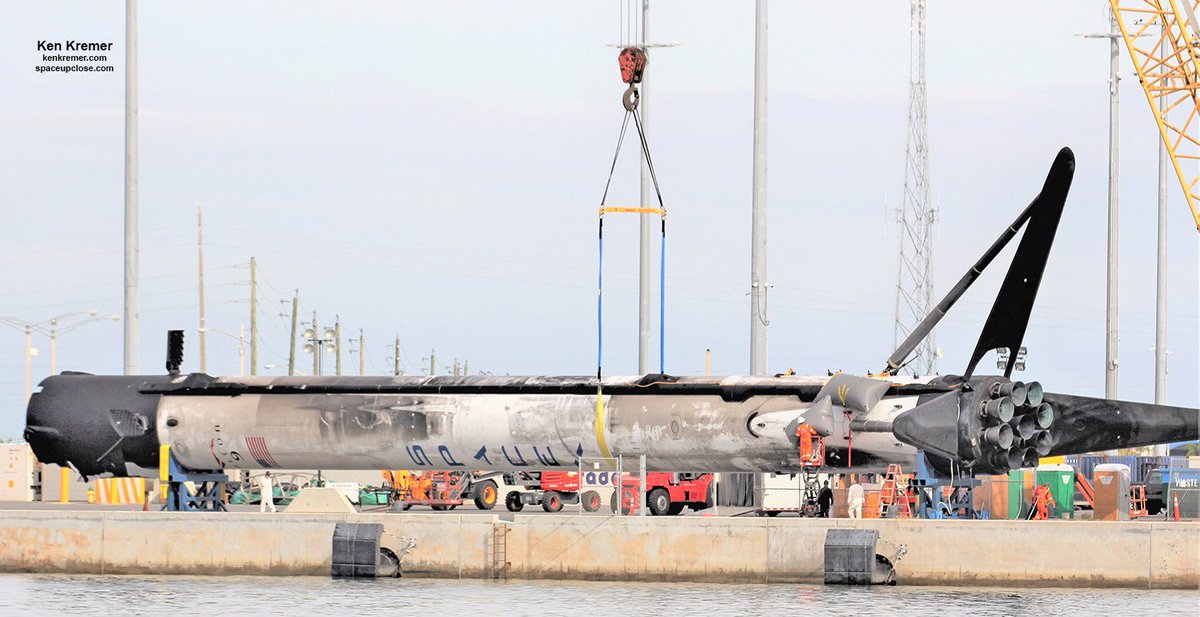
One engine bell got badly bent up. Scott Manley mentioned it probably got bent by the "missing" leg, when that leg came off. The leg apparently was removed on purpose (port is probably too shallow otherwise), not as a result of the water landing.
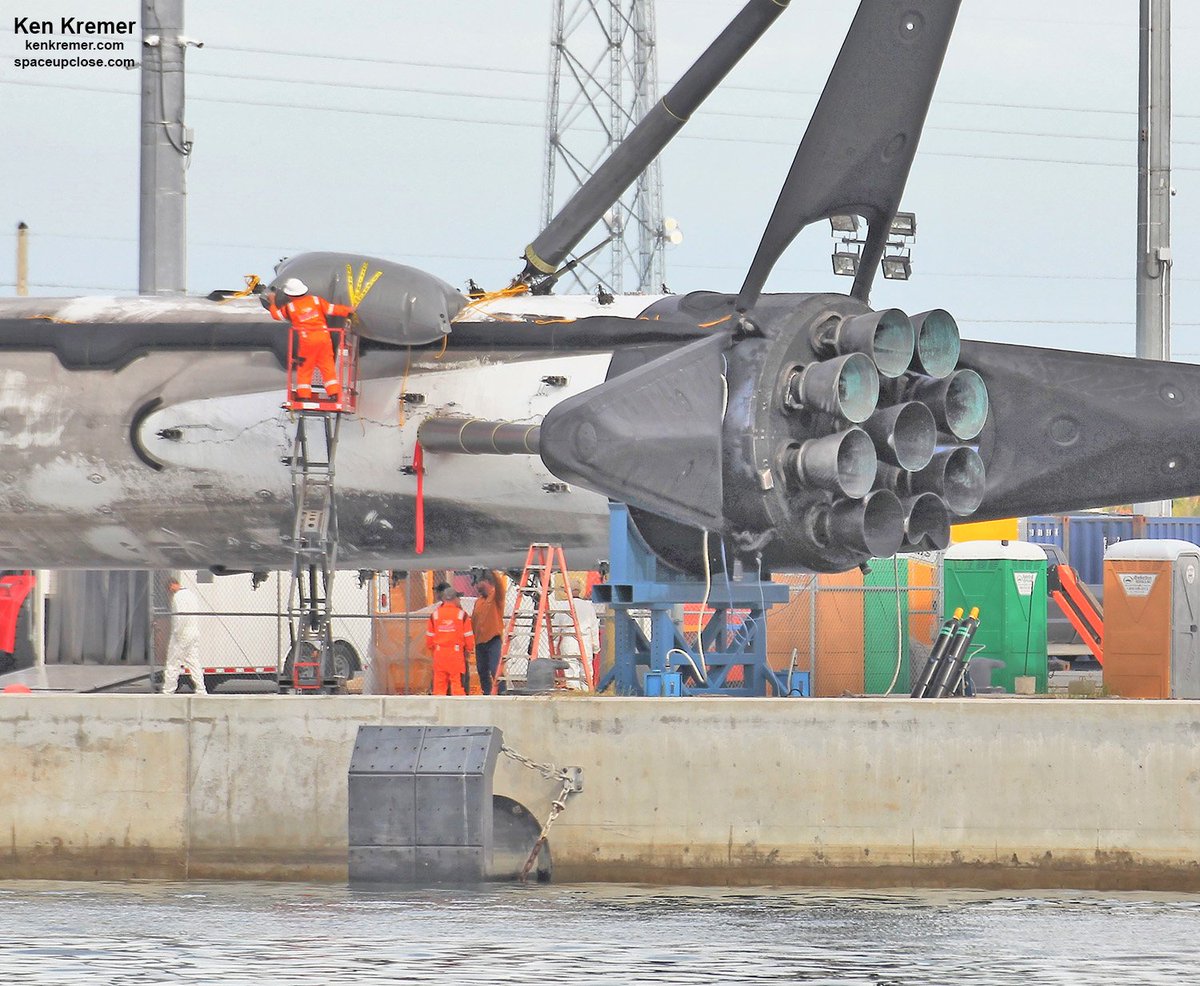
Two EXCELLENT videos by Tim Dodd (Everyday Astronaut), and Scott Manley
Photos by Ken Kremer

One engine bell got badly bent up. Scott Manley mentioned it probably got bent by the "missing" leg, when that leg came off. The leg apparently was removed on purpose (port is probably too shallow otherwise), not as a result of the water landing.

Two EXCELLENT videos by Tim Dodd (Everyday Astronaut), and Scott Manley
Last edited:
There is a nice patina developing on those engine bells  .
.
Hopefully there is only mainly surface corrosion and they can fly the thing again. Good learning exercise anyway. Having the recalcitrant hydraulic system available for autopsy is priceless information for the future.
Hopefully there is only mainly surface corrosion and they can fly the thing again. Good learning exercise anyway. Having the recalcitrant hydraulic system available for autopsy is priceless information for the future.
Shot that shows the size of the grid fins:
https://mobile.twitter.com/w00ki33/status/1071463546494451712
a lot bigger than I realized.
Tony
https://mobile.twitter.com/w00ki33/status/1071463546494451712
a lot bigger than I realized.
Tony
- Joined
- Jan 17, 2009
- Messages
- 5,204
- Reaction score
- 1,547
A very impressive Photoshop....

..... Except that even more impressively, that is REAL.
As told by photographer Ken Kremer:
"2 Marvels of Technology and ships passing at sea- Floating #SpaceX#Falcon9 arriving and USS Indiana nuclear sub departing Port Canaveral & Jetty Park Pier. United States Navy. Soaring to Space and Submerging at Sea. #USSIndiana. "


..... Except that even more impressively, that is REAL.
As told by photographer Ken Kremer:
"2 Marvels of Technology and ships passing at sea- Floating #SpaceX#Falcon9 arriving and USS Indiana nuclear sub departing Port Canaveral & Jetty Park Pier. United States Navy. Soaring to Space and Submerging at Sea. #USSIndiana. "

Looks like the link I posted is a bit wonky, here's another version:Shot that shows the size of the grid fins:
https://mobile.twitter.com/w00ki33/status/1071463546494451712
a lot bigger than I realized.
Tony
https://twitter.com/w00ki33/status/1071463546494451712
Tony
ps: those are great photos of the booster and sub, George, I followed the photographer on Twitter since he has a ton of great SpaceX photos.

I met Ken Kremer earlier in the year in Titusville and purchased some pics off him. Nice guy, and a good photographer!
- Joined
- Jan 17, 2009
- Messages
- 5,204
- Reaction score
- 1,547
Iridium-NEXT launch that had been scheduled for Dec 30th has slipped to Jan 7th.
So, last launch scheduled for this year is USAF GPS III-1 on December 18th from Vandy (an expendable launch due to the need for maximum performance to use up fuel needed for landing. So the recent hydraulic problem for landing won't require a fix).
That one would make it 21 launches for this year. Last fall SpaceX announced 28 for 2018. I think I said at the time I didn't expect more than 24 based on past overoptimistic launch schedules vs actual flown.
Interesting graphic showing how many spacecraft are docked/berthed with ISS, CRS-16 the newest arrival:
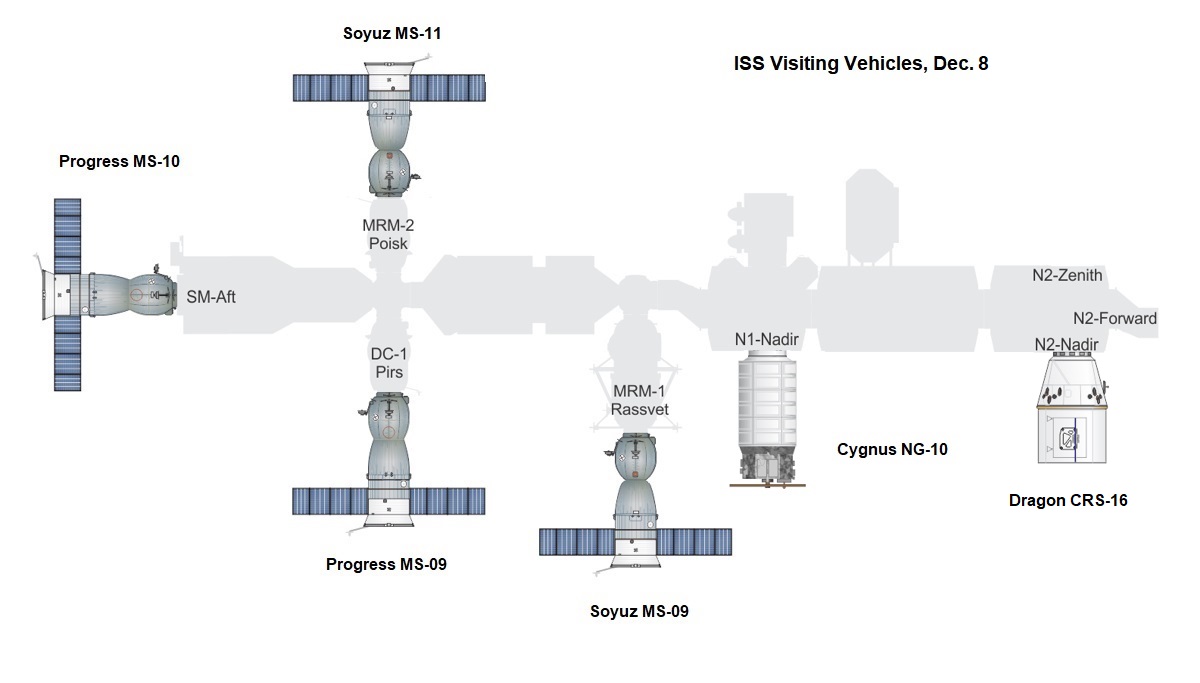
A computer 3D image:
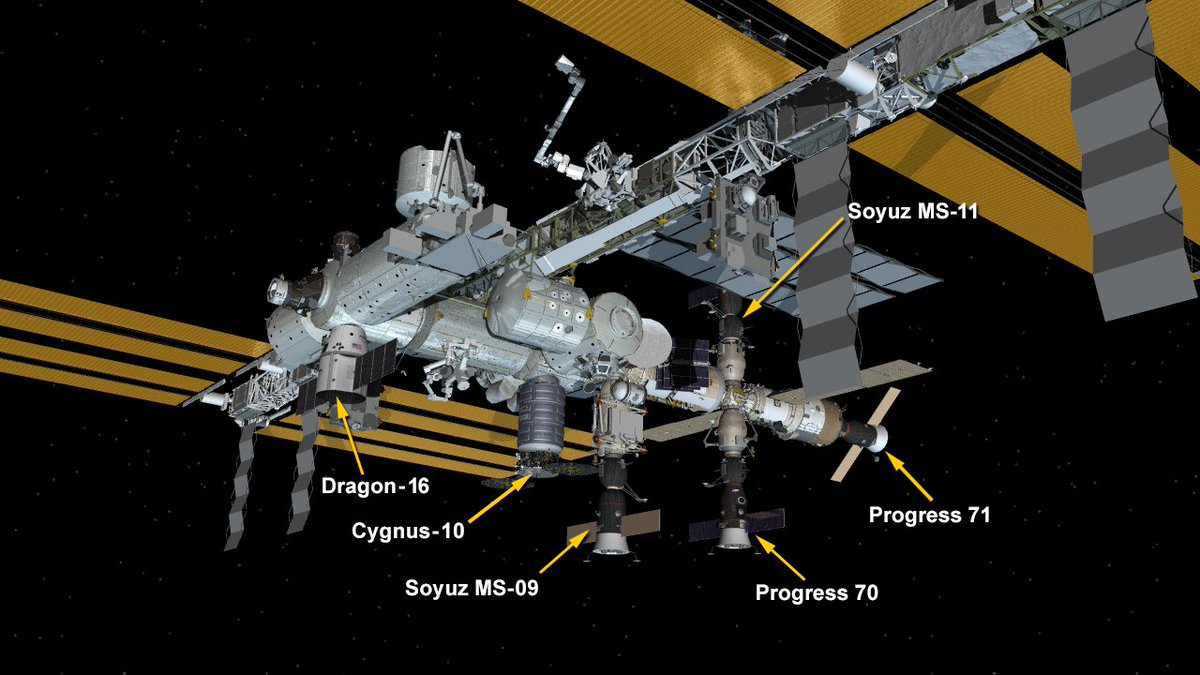
So, last launch scheduled for this year is USAF GPS III-1 on December 18th from Vandy (an expendable launch due to the need for maximum performance to use up fuel needed for landing. So the recent hydraulic problem for landing won't require a fix).
That one would make it 21 launches for this year. Last fall SpaceX announced 28 for 2018. I think I said at the time I didn't expect more than 24 based on past overoptimistic launch schedules vs actual flown.
Interesting graphic showing how many spacecraft are docked/berthed with ISS, CRS-16 the newest arrival:
A computer 3D image:

Last edited:
- Joined
- Jan 17, 2009
- Messages
- 5,204
- Reaction score
- 1,547
GPS III SV01 MISSION - Planned launch Tuesday Dec 18th at 9:11 AM EST.
"SpaceX is targeting Tuesday, December 18 for launch of the United States Air Force’s first Global Positioning System III space vehicle (SV) from Space Launch Complex 40 (SLC-40) at Cape Canaveral Air Force Station, Florida. The 26-minute launch window opens at 9:11 a.m. EST, or 14:11 UTC. The satellite will be deployed to medium Earth orbit approximately 1 hour and 56 minutes after liftoff. A 26-minute backup launch window opens on Wednesday, December 19 at 9:07 a.m. EST, or 14:07 UTC.
Due to mission requirements, SpaceX will not attempt to land Falcon 9’s first stage after launch.
You can watch the live launch webcast below, starting about 15 minutes before liftoff, and find out more about the mission in our press kit." https://www.spacex.com/sites/spacex/files/gps_iii_press_kit.pdf
"SpaceX is targeting Tuesday, December 18 for launch of the United States Air Force’s first Global Positioning System III space vehicle (SV) from Space Launch Complex 40 (SLC-40) at Cape Canaveral Air Force Station, Florida. The 26-minute launch window opens at 9:11 a.m. EST, or 14:11 UTC. The satellite will be deployed to medium Earth orbit approximately 1 hour and 56 minutes after liftoff. A 26-minute backup launch window opens on Wednesday, December 19 at 9:07 a.m. EST, or 14:07 UTC.
Due to mission requirements, SpaceX will not attempt to land Falcon 9’s first stage after launch.
You can watch the live launch webcast below, starting about 15 minutes before liftoff, and find out more about the mission in our press kit." https://www.spacex.com/sites/spacex/files/gps_iii_press_kit.pdf
Hold, hold, hold. Onboard computer hit an abort condition @ T-7:01. Their window closed for today so they will review, reset and try in 24 hours. Hopefully nothing too serious that can't be resolved over night.
- Joined
- Jan 17, 2009
- Messages
- 5,204
- Reaction score
- 1,547
New launch window opens at 9:07 EST Wednesday the 19th.
Launch abort today was called when the LOX loading of stage 1 reached thermal limits beyond the design compensation. The F9 has used super-chilled LOX and RP-1 in order to get the most fuel into the tanks for the last 3 years.
Launch abort today was called when the LOX loading of stage 1 reached thermal limits beyond the design compensation. The F9 has used super-chilled LOX and RP-1 in order to get the most fuel into the tanks for the last 3 years.
Today's launch scrubbed again.
https://twitter.com/SpaceX/status/1...18/falcon-9-gps-3-sv01-mission-status-center/
https://twitter.com/SpaceX/status/1...18/falcon-9-gps-3-sv01-mission-status-center/
- Joined
- Jan 17, 2009
- Messages
- 5,204
- Reaction score
- 1,547
SCRUBBED for Wednesday for whatever reason.
No new launch date yet.
They didn't say, just "out of range".
No new launch date yet.
.......was it an over or under temp?
They didn't say, just "out of range".
No, they keep saying, "Out of family." Which is unfamiliar to me. Does that make sense to anyone else?SCRUBBED for Wednesday for whatever reason.
No new launch date yet.
They didn't say, just "out of range".
- Joined
- Jan 17, 2009
- Messages
- 5,204
- Reaction score
- 1,547
OK, so they DID say “out of family”. What does that mean? I have no freaking idea why they used the word “family”. So I said out of range which is what one would expect a temperature sensor reading that is BAD (or not nominal) one way or another to mean. For all I know someone at SpaceX had a typo or auto-correct or used a dumb word choice that they’re living with now.
Covfefe?
So yeah, I “interpreted” the stupid phrase they used into something that makes sense.
I find no use of the term “out of family” for sensor readings in Google before yesterday, so this is not some pre-existing aerospace terminology.
Its like at times officials at SpaceX spit out a tweet without thinking or taking a moment make sure they are providing clear unambiguous information.
Meanwhile, currently planned for Jan 17th, is the first Demo launch of a Dragon-II spacecraft (Crew Dragon) that will fly unmanned to the ISS. If that flight plus an in-flight abort test later go well, then the next Dragon-II launched into orbit will have a NASA crew onboard (to fly to the ISS).
Look at the cool black color of the "trunk"

Well, it's not paint And it's not a funky carbon fiber pattern either. It's covered with Solar Cells, rather than using deployable panels.
The stubby fins are used for making it aerodynamically stable if it has to abort. It made a successful pad abort test in May 2015.
Covfefe?
So yeah, I “interpreted” the stupid phrase they used into something that makes sense.
I find no use of the term “out of family” for sensor readings in Google before yesterday, so this is not some pre-existing aerospace terminology.
Its like at times officials at SpaceX spit out a tweet without thinking or taking a moment make sure they are providing clear unambiguous information.
Meanwhile, currently planned for Jan 17th, is the first Demo launch of a Dragon-II spacecraft (Crew Dragon) that will fly unmanned to the ISS. If that flight plus an in-flight abort test later go well, then the next Dragon-II launched into orbit will have a NASA crew onboard (to fly to the ISS).
Look at the cool black color of the "trunk"

Well, it's not paint And it's not a funky carbon fiber pattern either. It's covered with Solar Cells, rather than using deployable panels.
The stubby fins are used for making it aerodynamically stable if it has to abort. It made a successful pad abort test in May 2015.
Last edited:
Nytrunner
Pop lugs, not drugs
Guess they used the central post that pushes the 2nd stage away to lift rather than the interstate itself.
Definitely. The damaged interstage seems like it'd be terrible for lifting. Imagine lifting up a steel pipe by a cracked eggshell glued to the end
There is a nice patina developing on those engine bells.
Hopefully there is only mainly surface corrosion and they can fly the thing again. Good learning exercise anyway. Having the recalcitrant hydraulic system available for autopsy is priceless information for the future.
Eesh, the salt water will be doing a nasty job on things. The inner liner isn't just a smooth shell. It's got channels and subtle geometries which are purposeful, and I'm not looking forward to that cleaning job. I guess it depends on which erodes worse, cleaning off the crud or being fired nominally.
I can clarify that 'out of family' means out of family with historical data. It's a well used term internally at SpaceX but obviously not so much elsewhere. So not a typo, just an internal term that's been surfaced to the public for the first time apparently.OK, so they DID say “out of family”. What does that mean? I have no freaking idea why they used the word “family”. So I said out of range which is what one would expect a temperature sensor reading that is BAD (or not nominal) one way or another to mean. For all I know someone at SpaceX had a typo or auto-correct or used a dumb word choice that they’re living with now.
Covfefe?
So yeah, I “interpreted” the stupid phrase they used into something that makes sense.
I find no use of the term “out of family” for sensor readings in Google before yesterday, so this is not some pre-existing aerospace terminology.....snip...
Tony
Similar threads
- Replies
- 5
- Views
- 635
- Replies
- 8
- Views
- 706
- Replies
- 29
- Views
- 2K
- Replies
- 6
- Views
- 2K
Latest posts
-
-
-
-
Estes: betting the business and the hobby on... retail?
- Latest: Initiator001
-
Wanted 8" Composite Warehouse tube, coupler, and nose cone
- Latest: Conway Stevens
-





